Bata: From ghetto to Africa’s finest
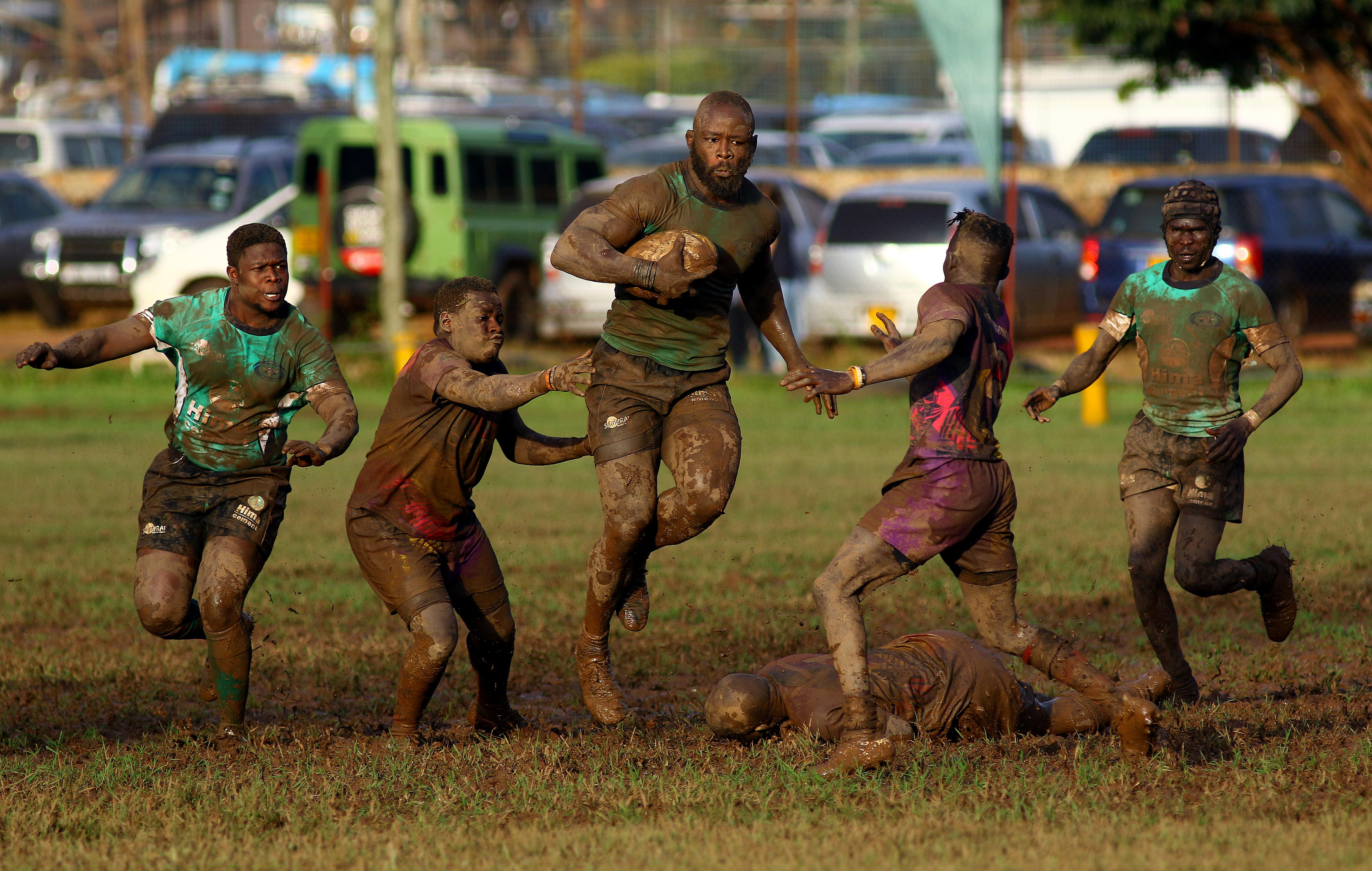
Better than all the best. The photo of Heathens’ loose forward Scott Oluoch launching an attack against Warriors players during a Uganda Cup match taken at Kyadondo Rugby Club in Kampala, won Batanudde, a Rugby Africa Media and Photography Award. PHOTO/John Batanudde
What you need to know:
Simply the best. Daily Monitor photojournalist John Batanudde recently won the inaugural Rugby Africa Media and Photography Award, sharing the US$3,000 prize money with Kenyan Dave Mwaura. But his journey to the top did not begin yesterday, having previously impressed with some memorable shots, writes Abdul-Nasser Ssemugabi
Veteran journalist William Pike believes some great stories come from ordinary people. One such story is in the Daily Monitor newsroom. It’s one of a small man, who speaks with a light lisp and a free smile and hardly wears long-sleeved shirts.
He is John Batanudde, whose photo emerged the best at the inaugural Rugby Africa Media and Photography Awards, two weeks ago.
But to those familiar, it was no surprise because this simple man they fondly call Bata, is such a wizard at photography.
Bata and Kenya’s Dave Mwaura, who won the best story award, each bagged US$1,500 (Shs5.3m) in prize money.
Straight outta ghetto
Bred in the Mengo-Kisenyi hood, Bata’s playmates were boys, who would later become sports stars, like boxing brothers Andaman and Farouk Daku, both based in the Netherlands.
He grew with love for photos. “Dad used to buy newspapers, and we mostly fought for the ones from Kenya, which had good sports pictures we would cut out and post on the walls using cassava starch.”
After his Advanced Level at Lubiri SS, Bata wanted to turn his passion into a profession. Having learnt a few skills in photography, he started making some money and his auntie connected him to a gig with European tourists, and they were impressed.
“In addition to the pay, the Mzungu later returned with a Canon 70-200mm camera, as a token of appreciation.”
Now he had the gadget, but he needed to put it to optimum use.
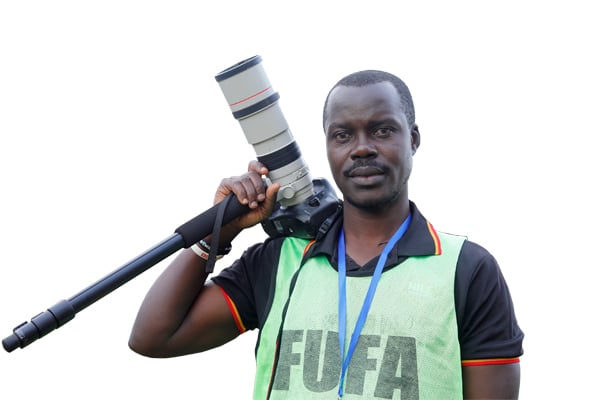
John Batanudde
And when Bata saw a job advert in the Red Pepper, in 2005, he stormed the sports desk in Makerere-Kavule, without any written application.
“I introduced myself to Allan Ssekamatte who referred me to Gazza, (Charles Kodiri) who was the sports editor,” Bata recalls.
The next day he walked in with a huge case carrying his Canon and “I got the job, just like that.”
His first assignment flopped as he was bounced at Nakivubo Stadium and the next day Gazza gave him an introduction letter.
Still, some bouncers gave him a hard time because of his lean stature. But soon, that came to pass as he rubbed shoulders with field marshals like New Vision’s Mpalanyi Ssentongo, Monitor’s JB Ssenkubuge (RIP), Eddie Chicco, et al. But the man who mentored him in photojournalism is the soft-spoken Micheal Nsubga, also of the New Vision.
“He could always guide me about camera angle, settings and everything else,” Bata credits.
Gazza says by then the Pepper was evolving into a daily, and Elijah Rwabwoni, the senior sports photographer by then, was becoming unreliable. So Bata’s entry was a timely pain reliever.
“Bata quickly impressed with his discipline, hard work and an eagle eye for a news picture,” Gazza recalls.
Though football was his first love, Bata is versatile and habitually produced compelling pictures from athletics, boxing, volleyball, motorsport, name it.
“This made him a newsroom darling, every editor wanted to assign,” Gazza says. And soon, Bata’s photos would spread to all pages from back to front.
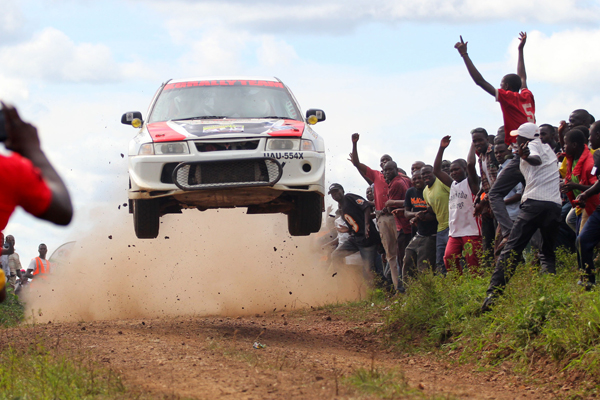
Top picks. Some of Bata’s best shots include Musa Kabega and Rogers Sirwomu flying their Mitsubishi Evo 6 during an Indenpendence Day Rally in 2016
Camera tricks
Bata’s uncle Badru Ssebunnya attracted him into motor rally and he carried his camera at motorsport events “but I could take photos from a very long distance because I feared shooting from close range.”
So how did he finally master the art? He says excellence in photojournalism comes out of preparation and luck: being in the right place, having the right gadget and of course clicking at the right time.
“Like in motorsport, you pray that the driver does some crazy stuff in front of you,” he says.
Motorsport photography also requires bravery, “because as you wait for the driver’s crazy stuff, you might become a victim.”
Fair enough. Motor rally fields are not as neat as football pitches; you might survive a speeding car but swallow that cloud of dust or hit an anthill or misstep into a pothole. And the risks are higher on a muddy field because the vehicles are uncontrollable.
“So at motorsport events, we first survey the area to establish safe spots and escape routes and we don’t shoot near crowds; their excitement is a recipe for danger.”
‘My best photo moment’
Remember the first edition of the Red Pepper that exposed ministers and Members of Parliament dosing during President Museveni’s state of the nation address?
Bata was the man behind the lens. His boss wanted to produce something unique that neither Daily Monitor nor the New Vision could think of.
“My boss (Arinaitwe) Rugyendo needed just two photos of those big people dosing…but it wasn’t as simple as that,” Bata recalls.
It was his first time in Parliament and the President’s tight security detail did not help matters.
Journalists from ‘small’ media houses were denied access to the House.
Bata was let in but wondered whether he would accomplish the mission.
“Luckily, the bigwigs started dosing, I switched off the flash to avoid attracting attention and I went on a shooting spree,” Bata retells with a stubborn smile.
“Someone on the President’s press team wanted to see whether I had taken any photos but I quickly took a few random shots which I showed him before I stormed out.”
The next morning Bata became a celebrity in the newsroom. He produced over 50 jaw-dropping shots of Vice President James Ssekandi, Kahinda Otafiire, Henry Kajura, among ministers and legislators, sleeping along the President’s address.
Bata says, many others were spared the shame in fear of causing trouble for the Pepper.
Gazza says that Red Pepper was struggling to sell 8000 copies but the Sleeping Nation edition sold over 36,000 copies.
And many important persons, who were the paper’s biggest critics, called in to commend Rugyendo’s team for a fantastic job.
“That is my best photo event, ever,” Bata says.
Bata’s work became an eye-opener and a trendsetter as all media houses, print and broadcast, made it a habit to expose bigwigs sleeping at public events.
But Gazza regrets that all Bata got for such brilliance was transport refund, and those photos did not carry his photo credit.
“They pretended to be protecting him but they intentionally denied him his due moment to shine,” he adds.
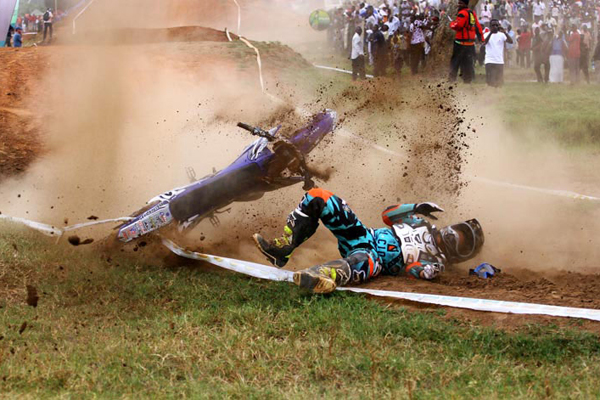
Rider Paddy Blick Jr loses control of his bike in Busika. PHOTO/ JOHN BATANUDDE
It was after that epic coverage that Bata was assigned to cover President Museveni’s campaign trail in 2011 and 2016.
Blue-Oranje love
When the Netherlands won the 1988 Euro final, Bata’s boyhood friend Yawe was over the moon and wanted all the boys to join the Oranje wagon.
He had always lectured them about international football, how Dutch stars like Ruud Gullit, Van Basten were shining in Italian clubs. He also brought them portraits of mostly Dutch icons and retold sports stories he had heard over the BBC and DW radios.
Bata and his younger company had no choice but to believe Yawe, who was a good years their senior.
Yawe spiced up his infatuation by offering soda to whoever supported Dutch.
Some, who watched Football Made in Germany, supported Germany, but Bata could not resist the soda temptation.
During the time of USA 94 World Cup, European club soccer was slowly creeping into the Ugandan market. Bata recalls former SC Villa chairman sponsoring a show on UTV that relayed the European league games two weeks later.
Back home, Bata was already a Villa fan but had not chosen which club to support abroad. The games he watched on UTV were in black and white and he had developed a soft spot for Arsenal. But exposure to colour tv showed him that Chelsea wore blue and Gullit’s transfer from AC Milan to the London club in 1995, sealed his combination for The Blues: Villa and Chelsea and the Dutch.
Two years later, Gullit’s magic as coach-player gave Chelsea the FA Cup, their first silverware in decades, after beating Middlesbrough in the 1997 final. It was also Bata’s first trophy as a Chelsea fan.
Roberto Di Matteo scored one of the goals but Bata, like most Chelsea diehards, gave most credit to another Italian—Gianfranco Zola, who had joined from Parma a year after Gullit’s arrival.
The Dutch door at the Bridge would remain open and later let in the prolific but ‘selfish’ Jimmy Floyd Hasselbaink, according to Bata, who had won the Spanish La Liga Golden Boot with Atletico Madrid in 2000. He would win the EPL Golden Boot in his first season.
The following season, Boudewijn Zenden, an industrious left winger joined from Barcelona, though injuries blighted his three-year career at Chelsea.
Such is Bata’s affection for the Dutch that his best Chelsea coach is Guus Hiddink—a Dutchman who managed the club twice, but on an interim basis.
Gifted right back
Bata is not just a football lover, “he was a legit right back, gifted with a good first touch, pace, power, ability to pass and the heart to tackle anyone,” says recent Villa coach Edward Kaziba, who handled Bata at Miracle FC, when the now-defunct club was fighting to return to the top flight.
That club was once home to stars like Edgar Watson, Gibby Kalule, Andy Lule, Robert Mukiibi, et al.
Bata also recalls his years at Kadiba FC, also in Lungujja-Mengo, where Edward Golola, of Vipers and St Mary’s Kitende instilled in them the grit-grace approach.
“There were some sessions which he dedicated to grit: hard tackling, pushing, running, etc,” Bata recalls.
“And in some games he would instruct us to first scare the opponent with the rough game, as we grew into the match and most cases it worked.
Bata also worked as a gym instructor in Mengo, and lifting weights and power training was his and his friends’ secret to have the grit in small bodies that helped them scare the hell out of bigger opponents.
“With that approach we could take on anyone,” Bata adds.
“Whenever I see him I remind him that he ‘strangled’ his football,” says Kaziba, who strongly believes had Bata stayed on the pitch, he would have made it to the Uganda Cranes. Another wasted talent? Perhaps not, because on several Cranes outings, home and away, Bata is on the touchline, clicking.
Free spirit
Some photojournalists can’t share photos with colleagues from rival media houses. Others give what they deem as garbage.
Bata is different. We first met in 2014 at a boxing AGM, my first event, just weeks into my career with Monitor. But he freely shared the event’s photos with me. Four years later, he crossed from Namanve to Namuwongo Road and I attest that sharing photos, equipment, snacks and knowledge is his habit.
“Bata is a humble person and likes to learn. I treat him as a small-body-big-brain person,” says Fufa head of communications, Ahmed Masha, who has worked with Bata on several projects.
“He has grown from scratch to where he is now. He gives attention to detail on every project, irrespective of its magnitude. He is part of a crop of photographers like Stephen Mayamba, Ismail Mulangwa, Don Phil Mugabi and Aminah Babirye, who have defined photography with storytelling and captivating moments.”
Need I say more?
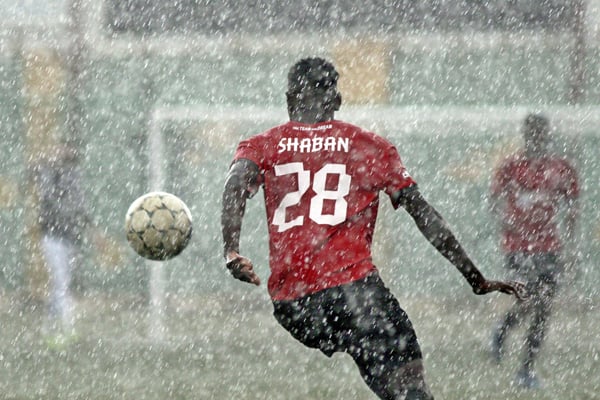
Vipers’ Shaban Muhammad playing football in the rain. PHOTO/John Batanudde
Aiming higher
The Africa awards introduced Bata to not only the rugby top brass but also the executives of multinational companies like Google, Uber, Jaguar Land Rover, Visa and Pfizer, who constituted the jury.
His winning image captured Heathens’ loose forward Scott Oluoch forcing his way past two Warriors players in a Uganda Cup match at Kyadondo Rugby Club. Two Heathens looked on as one Warrior lay face down on the soggy pitch. “The image captured was certainly action-packed! The runner with the ball has determination all over his face. He is much bigger and stronger-looking than those tackling him, and the mud makes catching him almost impossible–a metaphor for the struggles one has to go through to win,” said juror and chairman Standard Bank Group, Thulani Gcabashe.
Another juror and vice president Europe–Middle East–Africa of Harley Davidson, Dr Kolja Rebstock, added: “I myself love taking pictures and I know how difficult it can be at times to freeze and capture the right sharp moment at the right angle. You need an eye and heart for seeing a beautiful background and capturing the precise emotion behind an image. It was indeed a very hard choice to make and I would like to congratulate all participants and the winners.”
For Bata that’s inspiration to shoot for more.
“I also want to encourage colleagues to stay focused because my journey has been long. I remember using a very inferior camera when I was starting out but here I am.”
Bata says whenever on duty he wants to bring out something unique that surprises even you who attended the event.
And he seems to have mastered that, no wonder he has been voted the best sports photographer in the 2016 Uganda Press Photo Awards; won the best photographer award in the Uganda Premier League for 2016 and 2017 and the Sports Journalist Choice Awards for the same years, before hitting the continental milestone.
But Gazza, who joined the Monitor newsroom in 2018, says Bata is worth more than just awards. “He should aim higher. In everyone’s eyes Bata is a winner, so he should think of lecturing at university, do consultancy work, etc. It’s not too late, though.”




